Geoscience Reference
In-Depth Information
Within a given region, yardang summit elevations may be
protected by cappings such as carbonates or reg derived
from earlier fluvial deposits. Where summit elevations
are regionally accordant, such as the 60 m elevations of
the Lut Desert yardangs, earlier surfaces are suggested
(Krinsley, 1970).
winds have a seasonal component and one may erase the
action of the other over the course of a year. Moreover,
longer-scale climatic changes involving both wetter and
drier climates than today profoundly shape the landscape
(Haynes, 1980, 1982), changing basins from depositional
to erosional systems.
Horner (1932) details the interaction of wind (both
abrasion and deflation), water and mass movement pro-
cesses in his discussion of the yardangs of Lop Nor. Rain-
fall creates strong films of silty material on yardang sur-
faces, which protects them from deflation. At the foot of
the yardang, the attack of drifting sand undermines the
rock and unsupported blocks fall down to form talus. The
silty film no longer protects the sediments revealed by
block failure and loose particles of fine sand are deflated
by the wind. The remains of copses on some yardang sur-
faces provide evidence that the area was previously better
watered (H orner, 1932).
21.2.3.3
The role of the water table
In yardangs formed on playas, the height of the water
table plays a major role in yardang formation (Haynes,
1980). As the water table rises and falls in response to
climatic change, yardangs may be destroyed or formed.
For instance, yardang formation in association with the
excavation of the Lut Formation, Iran, was initiated by
a lowering of the water table (Krinsley, 1970). In tec-
tonically active areas, regional faulting may play a role
by modifying the terrain and changing water flow and
groundwater levels.
Water erosion
Although yardangs are largely considered to be wind ero-
sion features of extremely arid regions, both short- and
long-term climatic fluctuations mean that water erosion
inevitably plays a major role in yardang formation and
modification. Fluvial erosion often provides the original
lineations that are subsequently exploited by the wind; rain
modifies the surface of the form by gullying and solution
processes (Figure 21.6); interyardang floods modify and
steepen the yardang sides (Figure 21.7); and fluctuations
in the water table determine the depth to which yardangs
are excavated in soft sediments. Thus, the yardang field
21.2.3.4
Formative processes: wind, water, mass
wasting and weathering
Yardangs are formed by two fluids - wind and water. The
significance of each of these processes varies both spa-
tially and temporally. From a temporal perspective, the rel-
ative significance of wind and water vary as the yardangs
form and evolve. Fluvial erosion is often deemed critical to
the initial dissection of the landscape; only in later stages
does the wind become dominant (Horner, 1932; Vincent
and Kattan, 2006). Furthermore, both rainfall and erosive

